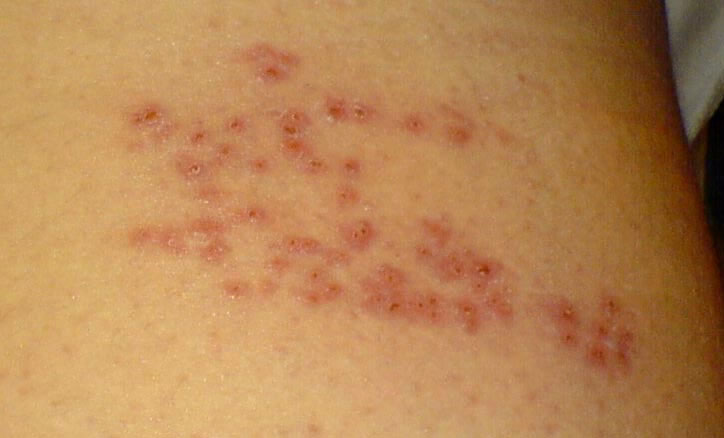Shingles (herpes zoster; zoster; or zona) is a painful, blistering skin rash, most commonly appearing as a band or stripe on one side of the body. The rash evolves into clusters of blisters, which fill with fluid, and finally, within seven to ten days, the blisters crust over. Eventually, the crusts slough off, and the skin heals.
Because it is a virus, shingles is incurable, though most individuals who suffer the illness only experience it once, without recurrence, and fully recover. Shingles treatment attempts to help minimize the pain, shorten the duration of a breakout, and reduce or eliminate complications. Earlier self-diagnoses of shingles leads to earlier treatment by a physician. Shingles usually clears within 2-3 weeks.
Occasionally, one suffers a lasting pain called “postherpetic neuralgia” that can continue for months or even years. This happens when the nerves have been damaged during a shingles outbreak. This complication is more likely to occur in people 60 years of age or older. Those who experience continued dizziness, weakness, extended pain or rash on the face, changes in vision, confusion, or a rash that continues to spread should seek help from his or her primary physician immediately.
Details of Shingles Causes
The same virus that causes chickenpox, called varicella-zoster, also causes shingles. Anyone who has had chickenpox is susceptible to shingles, but those who have never had chickenpox can not develop shingles. After one recovers from chickenpox, the virus may sleep, or lie dormant, for years even decades. Eventually, it may reactivate and travel along nerve pathways to the skin, resulting in a shingles breakout. The specific reason for the virus’ resurgence is unclear; however, research shows that the weakening of the immune system caused by disease, stress, or aging, plays a strong role. Therefore, shingles is more common in older adults as well as individuals with naturally weak immune systems.
Varicella-zoster is part of a group of viruses called herpes, which can cause cold sores and genital herpes. But the virus that causes chickenpox and shingles is not the same as herpes simplex, which is responsible for the sexually transmitted disease. Throughout the world, the incidence rate of shingles every year ranges from 1.2-3.4 cases per 1,000 healthy individuals. This rate increases to 3.9-11.8 per 1,000 individuals at least 65 years of age. Antiviral drug treatment can reduce the severity and duration of shingles if started within 72 hours of the breakout.
Risk Factors of Shingles Causes
As with chickenpox or other forms of herpes, direct contact with an active rash can spread shingles to a person who has no immunity to the virus. Until the rash has developed crusts, it is extremely contagious, and one should avoid physical contact with anyone who has a weak immune system, newborns, and pregnant women. A weakened immune system can be caused by HIV/AIDS, cancer or cancer treatments, prolonged use of steroids, and drugs designed to prevent rejection of transplanted organs.
Shingles complications can range from minor skin infections to postherpetic neuralgia, which is continued pain long after the blisters have cleared. It occurs when damaged nerve fibers send exaggerated messages from the skin to the brain. Shingles in or around an eye (ophthalmic shingles) can cause painful infections that may result in vision loss. Depending upon which nerves are affected, shingles can cause an inflammation of the brain (encephalitis), hearing or balance problems, and facial paralysis. If the condition isn’t properly treated, bacterial infections may develop.
The shingles vaccine is recommended for all adults age 60 and older, whether or not they have had shingles previously. The shingles vaccine is used only as a prevention strategy, and is not intended to treat those who currently have the disease.
Featured Image Source: wikipedia.org








